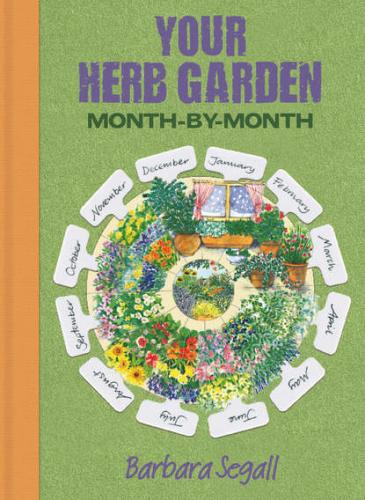There are two shrub roses that make central features of two quarters of this garden. I have underplanted them with bronze and green fennel and French tarragon. In summer the herbs grow tall, hiding the bare, thorny stems of the roses.
Under and up to the stone seat a downy and fragrant path of creeping thyme and chamomile releases its heady scents as I walk along it. Twining through the wild plum arch, jasmine perfumes the air around me as I pause to admire the shape, leaf texture and flowers of the herbs in this informal herb and vegetable garden.
Edged with brick, my herb circle has an old glazed chimney for its central feature. The herbs once grew in wedge shapes: sage, thyme, salad burnet and fennel, with large clumps of chives, garlic chives, lavender and lemon balm. Some, including thyme, salad burnet, fennel and sage are still in their wedge shapes. In spring there is a lovely display from the variegated lemon balm, hyssop provides pretty blue flowers, while the garlic chives have heads of starry white. There are also some asparagus crowns, rescued from other parts of the garden, and angelica regularly sows itself here. These give the circle height in late summer.
From a herb garden there are many rewards: for most gardeners the idea of creating and running a herb garden is one of the dearest dreams. It appeals to the herbalist, cook and gardener in us all.
In The Herb Garden Month-by-Month there are practical activities to undertake each month in the herb garden, as well as projects, many of which allow you to enjoy the plants indoors. Create the herb garden, with paths, benches, arches, even statuary. Then fill it with plants that will delight visual and aromatic senses as they grow – and still have more to offer as you use them in the kitchen, or preserve them for cosmetic, decorative, culinary and fragrant use later.
Each month is introduced by a scene-setting picture of the herb garden and an outline of the month’s activities. In the sections which follow are set out the principal tasks for the month, such as seed sowing, taking cuttings, harvesting and preserving herbs, or maintaining the herb garden. In each chapter there are herb profiles, each providing a full description of the plant, how to grow it, maintain, harvest and preserve it. Here, too, you will find general information on how to use the herb. There is an additional list of plants traditionally grown in the herb garden.
Calendula and feverfew;
THE BASIL COLLECTION
For years I have grown up to 15 different types of basil, including anise basil, bush basil, cinnamon basil, dark opal basil, Greek basil, Genovese basil, green ruffles, Holy basil, horapha or Thai basil, lemon basil, Neopolitana basil, purple ruffles, spice basil and sweet fine basil. They vary in size, fragrance, and size and shape of leaf and all are wonderful plants to grow in a hot, sunny border, in pots in the greenhouse, or, sown late in the season, to grow potted up specially, indoors in autumn and winter. I nip off most buds to encourage leaf formation, but let some go to flower, so I can enjoy their fragrance. I also harvest some for pot-pourri.
NOTE TO NORTH AMERICAN READERS
Not all these monthly projects will be appropriate for every region and will have to be adapted to your area.
SEASONS AND MONTHS
Under average conditions, the terms ‘early’, ‘mid’ and ‘late’ season as used throughout the book correspond to the following months:
SPRING
Early: March
Mid: April
Late: May
SUMMER
Early: June
Mid: July
Late: August
AUTUMN
Early: September
Mid: October
Late: November
WINTER
Early: December
Mid: January
Late: February
To find out more about a herb that is mentioned in the general text, look it up in the index, and you will be referred to its profile. Included in the herb profiles are one or two that might seem unusual. For example, Norway spruce, our familiar Christmas tree, is included, because I wanted to use its branches as backing for a festive herbal wreath and for garlands. (But it has other herbal uses too – if you buy a small, rooted tree in a pot, when you plant it outdoors after Christmas, it will soon begin to grow new shoots, and you can harvest these to make your own spruce beer for summer drinks!)
In the winter and early spring months there are indoor planning projects, while all through the summer there are activities centred around particular types of herb gardens. Grow a tea garden, for example, and learn how to harvest and use herbs to make relaxing teas, or grow a fragrant cosmetic garden and use its produce to make gentle home cosmetics.
Traditionally, herbs have many uses for remedying everyday ailments, both minor and major. There are specialist books available on herbal remedies, but if you are seriously interested it is wise always to consult a professional herbalist.
In this book, I have set out to look at herbs as intensely rewarding garden plants – culinary, decorative and cosmetic – that we can all enjoy throughout the year.
USEFUL HERBS
FRESH FROM THE GARDEN
Hyssop
Rosemary
Sage
Salad burnet
Thyme
Winter savory
FRESH FROM THE KITCHEN
WINDOWSILL
Chervil
Chives
Parsley
Winter savory
IN THE GREENHOUSE
French tarragon
Lemon verbena
Liquorice
Mint
Scented pelargonium
PLEASE NOTE
Any
